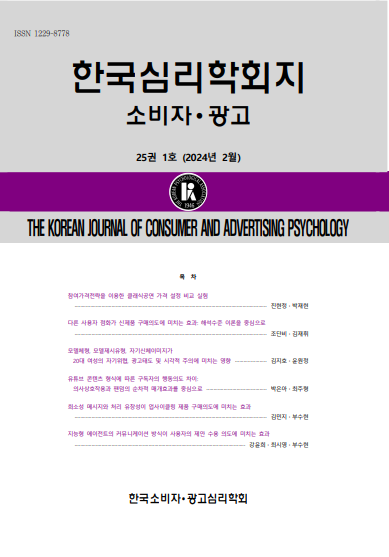open access
메뉴.png)
open access
메뉴 ISSN : 1229-8778
ISSN : 1229-8778
본 연구는 다이어트 맥락에서 다이어트 목표달성가능성에 영향을 미치는 요인을 고찰하고자 하였다. 특히, 본 연구에서는 기존 연구와 다르게 목표달성에 대한 목표달성정도(goal progress level)에 초점을 두지 않고, 자신의 목표수준(goal level)에 따라 다이어트에 대한 목표달성가능성이 달라지는지를 고찰하였다. 나아가 다이어트 목표수준이 목표달성가능성에 영향을 미치는 새로운 조절요인으로 다이어트에 대한 목표시점(연구 1)과 다이어트에 대한 실행의도(연구 2)의 효과를 제시하였다. 두 연구결과를 요약하면 다음과 같다. 먼저, 응답자들은 다이어트에 대한 목표수준이 높은 경우보다 목표수준이 낮은 경우에 목표달성가능성을 더 높게 지각하였다. 그리고 응답자들은 다이어트 목표시점이 가까운 경우에 비해 먼 경우에 다이어트에 대한 목표달성가능성을 더 높게 지각하였으며, 다이어트에 대한 실행의도가 낮은 경우에 비해 실행의도가 높은 경우, 다이어트에 대한 목표달성가능성을 더 높게 평가하였다. 그리고 목표수준과 목표시점 간의 이원상호작용 효과가 유의하게 나타났다. 구체적으로 감량목표 수준이 낮은 경우에는 목표시점에 관계없이 목표달성가능성을 모두 높게 지각하였으며, 감량목표 수준이 높은 경우에는 목표시점이 가까운 경우에 비해 먼 경우, 다이어트에 대한 목표달성가능성을 모두 높게 지각하였다(가설 1). 또한, 목표수준과 실행의도 간의 이원상호작용 효과가 유의하게 나타났다. 구체적으로 감량목표 수준이 낮은 경우에는 다이어트에 대한 실행의도에 관계없이 목표달성가능성을 모두 높게 지각하였으며, 감량목표 수준이 높은 경우에는 실행의도가 낮은 경우에 비해 실행의도가 높은 경우 다이어트에 대한 목표달성가능성을 높게 지각하였다(가설 2). 끝으로 목표수준이 목표달성가능성에 영향을 미치는데 있어 목표시점과 실행의도의 효과는 목표달성에 대한 확신성에 의해 매개되는 것으로 나타났다(가설 3).
This study investigated which motivation factors influenced on diet goal attainability. Different from previous studies, we focused on the effect of goal levels(high vs. low) rather than goal progress levels. Also, we postulate that the goal distance and implementation intentions play an essential moderating role in relationship between goal level and goal attainability. We conducted two studies to support our hypothesis. First, participants rated high goal attainability when the goal level was low(vs. high), the goal distance was far(vs. near) and the implementation intentions were low(vs. high). Also, according to the results of two-way interactions, study 1 revealed that as goal level decreases, consumers tend to evaluate in more positive manner to the goal attainability regardless of goal distance. On the other hand, when goal level was high(vs. low), participants rated high goal attainability of diet when was goal distance was far(vs. near)(H1). In Study 2, we found that the effect of goal level was differed by implementation intentions. According to the result of study 2, even if dieters had high(vs. low) level for diet goal, they rate high goal attainability of diet when implementation intentions were high(vs. low)(H2). Finally, we found that the certainty plays an essential mediating role in relationship between goal level and goal attainability(H3). We may draw several theoretical and practical contributions. Theoretically, we developed a step further in research in goal level and its related studies.
김재휘, 설하린 (2014), “자기조절자원의 소진이 자기통제에 미치는 효과: 심적 계정의조절 효과를 중심으로,” 한국심리학회지:소비자․광고, 15(1), 157-170.
세계일보 (2013), “전 세계 비만․영양실조 年손실 3조5000억弗”, 2013년 06월 5일자.
Achtziger Anja, Peter M. Gollwitzer, and Paschal Sheeran (2008). “Implementation Intentions and Shielding Goal Striving From Unwanted Thoughts and Feelings,” Personality and Social Psychology Bulletin, 34(3), 381-393.
Barney, Jay B., and Ricky W. Griffin. The Management of Organizations. Boston: Houghton Mifflin Company, 1992.
Carlson Kurt A., Margaret G. Meloy, and Elizabeth G. Miller (2013). “Goal Reversion in Consumer Choice,” Journal of Consumer Research, 39(February), 918-930.
Feather, Norman T. (1990). “Bridging the Gap Between Values and Actions: Recent Applications of the Expectancy-Value Model,”in Handbook of Motivation and Cognition:Foundations of Social Behavior, Vol. 2, ed. E. Tory Higgins and Richard M. Sorrentino, 151-192.
Fishbach Ayelet and Ravi Dharn (2005). “Goals as Excuses or Guides: The Liberating Effect of Perceived Goal Progress on Choice,” Journal of Consumer Research, 32(December), 370-377.
Fishbach Ayelet and Ronald S. Friedman (2003). “Leading Us Not Unto Temptation:Momentary Allurements Elicit Overriding Goal Activation,” Journal of Personality and Social Psychology, 84(2), 296-309.
Gollwitzer, P. M. (1999). “Implementation Intentions: Strong Effects of Simple Plants,”American Psychology, 54, 493-503.
Huang Szu-Chi and Ying Zhang (2011). “Motivational Consequences of Perceived Velocity in Consumer Goal Pursuit,” Journal of Marketing Research, 48(December), 1045-1056.
Koo Minjung and Ayelet Fishbach (2008). “Dynamics of Self-Regulation: How (Un)Accomplished Goal Actions Affect Motivation,” Journal of Personality and Social Psychology, 94(2), 183-195.
Koo Minjung and Ayelet Fishbach (2012). “The Small-Area Hypothesis: Effects of Progress Monitoring on Goal Adherence,” Journal of Consumer Research, 39(October), 493-509.
Locke, Edwin A. and Gary P. Latham (1990). A Theory of Goal Setting and Task Performance, Englewood Cliffs, NJ: Prentice-Hall.
Locke, Edwin A. and Gary P. Latham (2006). “New Directions in Goal-Setting Theory,”Current Directions in Psychological Science, 15(5), 265- 268.
Mukhopadhyay, Anirban (2009). “Indulgence as Self-Reward for Prior Shopping Restraint: A Justification-Based Mechanism,” Journal of Consumer Psychology, 19(July), 334-345.
Nunes Joseph C. and Xavier Drėze (2006). “The Endowed Progress Effect: How Artificial Advancement Increases Effort,” Journal of Consumer Research, 32(March), 504-512.
Shah, James Y. and Ron Friedman, and Arie W. Kruglanski (2002). “Forgetting All Else: On the Antecedents and Consequences of Goal Shielding,” Journal of Personality and Social Psychology, 83(6), 1261-1280.
Soman, Dilip and Amar Cheema (2004). “When Goals Are Counterproductive: The Effects of Violation of a Behavioral Goal on Subsequent Performance,” Journal of Consumer Research, 31(June), 52-62.
Wilcox Keith, Beth Vallen, Lauren Block, and Gavan J. Fitzsimons (2009). “Vicarious Goal Fulfillment: When the Mere Presence of a Health Option Leads to an Ironically Indulgent Decision,” Journal of Consumer Research, 36(October), 380-393.
Zhang Ying, Szu-Chi Huang, and Susan M. Broniarczyk (2010). “Counteractive Construal in Consumer Goal Pursuit,” Journal of Consumer Research, 37(June), 129-142.
Zhang Ying, Ayelet Fishbach, and Ravi Dhar (2007). “When Thinking Beats Doing: The Role of Optimistic Expectations in Goal-Based Choice,” Journal of Consumer Research, 34(December), 567-578.
Zhang Ying and Szu-Chi Huang (2010). “How Endowed versus Earned Progress Affects Consumer Goal Commitment and Motivation,”Journal of Consumer Research, 37(December), 641-654.
